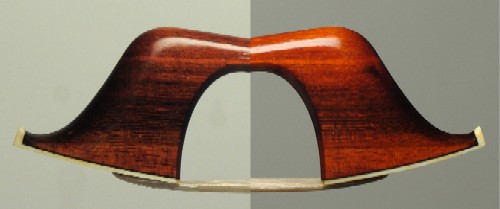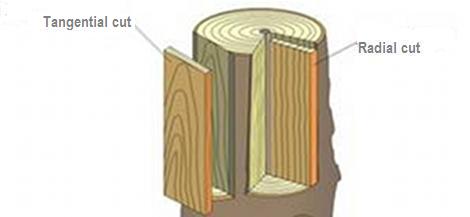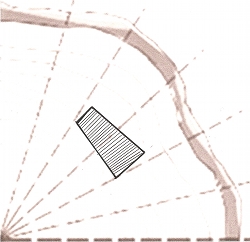WOOD CUTTING
The bow you can see here below, is the latest born at Navea Vera & Sarri's , and it was for us a real pride. From one side because Maestro Navea Vera has done a wonderful job, but especially because sticks at this level are about 1 out of 10,000!
This piece of wood owns all the qualities that a unique material should have, it really has everything! Sound velocity, density, color and, above all, a perfect cut !

Head of cello bow D.T. Navea Vera, with visible medullar rays on both sides
As already explained last week, both Pernambuco , spruce and maple are used for the construction of instruments thanks to the tension and regularity of their fibers. The longitudinal and transverse one interweave into a tissue which multiplies the capacity to vibrate and compact the wood giving it strength. However, it is necessary to cut the trunk in a proper way in order to not convert a miracle of nature into a human disaster. 
1) Radial and tangential cut
In the picture you can see two ways of cutting a tree trunk: radial and tangential. The correct way is, of course, the radial one , because it allows you to maintain the transverse fiber as untouched. The other one, the tangential or " the head one " completely destroys the medullar rays, sharply reducing the ability of this material to play and weakening the structure of the board that, being less strong is more prone to breakage. 
2) Cutting the violin board
As far as the instruments are concerned , after splitting the trunk in quarters, we proceed to cut the boards. As you can see in the picture, the wood is cut in a trapezoid way, trying to orient it toward the center of the plant, when the craftsman will build the instrument, he will cut this trapeze in half and he will build the right and left side of the instrument with it.
Not in every all boards or harmonics boards it is possible to maintain the cross-fiber throughout its length, but anyway, considering the width, we can can save a good part since the waste from the cut is acceptable. .
As long as you stay within the area of maple or spruce , things are not extremely easy, but when you use Pernambuco they become hellish! 
3) - Proper cut of the stick 
4) -Wrong cut of the stick
If using maple and spruce , a good cut is very important, it becomes absolutely significant for Pernambuco. If the cut is carried out as in the picture 3, the medullar rays are in the best position, but while in instruments the most important aspect is the increased transmission and consequently sound increase, in the bows the mechanics is the part that is be more concerned with it. If the stick is cut as in the picture 4, the medullar rays become a weakness point rather than a strength one, and the bow, that will be built, will be subject to serious breakage risks.
5) Cutting in boards
The shape of the bow makes the proper cut of Pernambuco even more difficult.. While speaking of violins, the cut is more natural because carried out into "slices", in order to get sticks it is compulsory to cut the quarters into boards. Obviously, by doing this, is not always possible to respect the right direction of the medullar rays, as often they are in a position that is not optimal but good, but very often they are in a disastrous position, and once out of ten thousand times they may be absolutely perfect.
This is the reason of the unicity of the newly born bow by Navea Vera & Sarri's ,when we saw this stick for the first time, Daniel and I felt like moved !
So long
Paolo.
|
 
 |